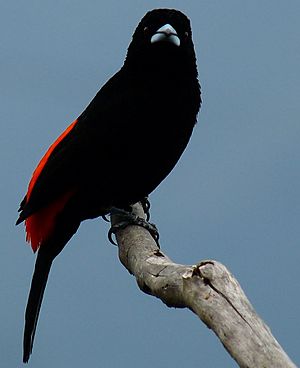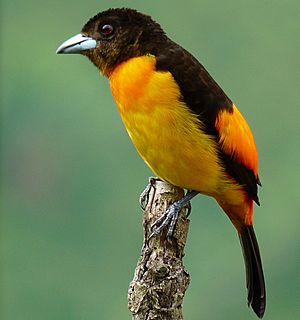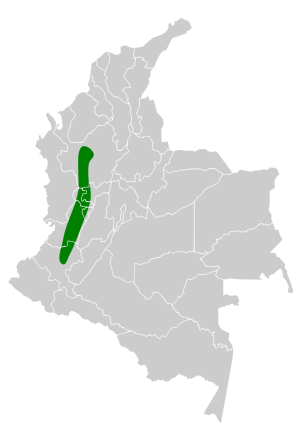Flame-rumped tanager facts for kids
Quick facts for kids Flame-rumped tanager |
|
|---|---|
 |
|
| male in Colombia | |
 |
|
| female in Colombia | |
| Conservation status | |
| Scientific classification | |
| Genus: |
Ramphocelus
|
| Species: |
flammigerus
|
 |
|
The flame-rumped tanager (Ramphocelus flammigerus) is a beautiful bird that belongs to the Thraupidae family, which is a large group of colorful birds often found in the Americas. This bird loves to live in places where forests are not too dense, like open woodlands and the edges of forests.
Contents
Meet the Flame-Rumped Tanager
These birds are known for their striking colors, especially the males. They were first described by scientists William Jardine and Prideaux John Selby in 1833. Flame-rumped tanagers are found in parts of Central and South America. They prefer areas with some trees but also open spaces, making it easy for them to find food and build nests.
Where Do They Live?
You can find the flame-rumped tanager in a region called Tumbes-Chocó-Magdalena. This area stretches across several countries, including Panama, Colombia, Ecuador, and Peru. They like warm, humid climates, which are common in these tropical regions.
Two Types of Flame-Rumped Tanagers
There are two main types, or subspecies, of the flame-rumped tanager. The most common one is called icteronotus. Sometimes, people even think this type is a completely separate species, and they call it the lemon-rumped tanager.
The other type is the flammigerus, which lives mostly in the Cauca Valley in Colombia. Even though they look a bit different, these two types can sometimes have babies together. This means they are closely related!
Spotting the Males and Females
It's pretty easy to tell the male and female flame-rumped tanagers apart because they have different colors.
Male Tanagers
Male tanagers of both types are mostly black. They have a cool, pale bluish beak that has a thin black tip. The most exciting part is their rump (the lower part of their back, just above the tail).
- If you see a male P. f. icteronotus, its rump will be bright yellow.
- But if you spot a male P. f. flammigerus, its rump will be a fiery red! This is where the "flame-rumped" name comes from.
Female Tanagers
Female tanagers are also beautiful, but their colors are a bit more subtle than the males'.
- For the female P. f. icteronotus, her head, wings, and tail are a dark brownish-black. Her belly and chest are mostly yellow, and her rump is yellowish too.
- The female P. f. flammigerus has a similar dark head, wings, and tail. However, her rump, the area around her vent (under her tail), and her chest are a lovely orange-red color. This makes her look a bit like the male flammigerus in terms of rump color, but less intense.
See also
 In Spanish: Tangara flamígera para niños
In Spanish: Tangara flamígera para niños


